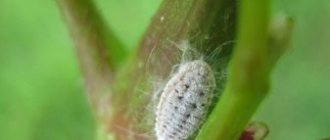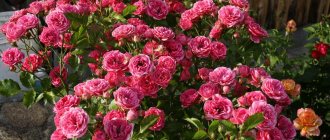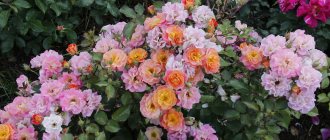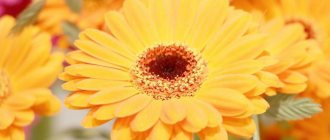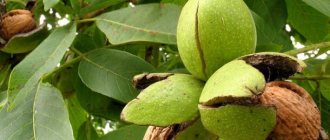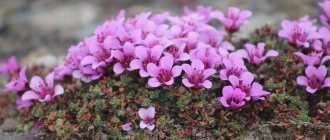Origin of garden geranium
South Africa is considered the birthplace of perennial geranium. This flower was brought to Europe in the 17th century. At the beginning of the 18th century, it came to Russia, and in the mid-19th century, many aristocrats began to grow it as a garden plant.
Perennial blooms with lilac flowers
Thanks to the efforts of breeders, more than 400 species of geranium have been bred; they differ in color and shape of flowers.
Attention! Many inexperienced gardeners and flower lovers mistakenly call the plant garden or outdoor pelargonium. The name is incorrect, although pelargonium also belongs to the Geraniaceae family.
General description of the plant
Pelargonium is the name of a perennial or annual crop, originating in South Africa. The crop occurs in the form of a shrub or herbaceous crop. The buds of the bush are formed into shields or umbrellas; there are varieties with large terry “caps” of buds. The stems are characterized by a straight, branched configuration, the leaves are decorative and attractive in shape.
Varieties of culture
There are more than 250 varieties of the crop, all of which grow in South African conditions. The most popular in our latitudes are:
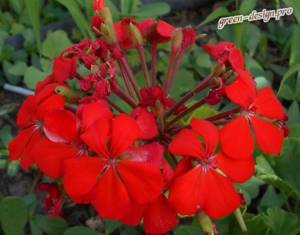
Pelargonium zonale
- Zonal (Pelargonium zonale). It is distinguished by original leaves with drawings. During the cold season, it is recommended to replant from open ground into a flower pot and hide it in the basement. This species is drought-resistant and is characterized by buds of white, red, crimson, and pink tones. The shape of the flowers is umbrella-shaped, with a terry structure. Does not like waterlogging. The most famous varieties: Rumba Fire, Bravo Pastel.
- Ivy leaf (Pelargonium peltatum). The leaves of the plant are green with a red edge and have slight drooping. It is distinguished by shoots of a cascading configuration, the length of which is a maximum of 90 cm. They are dug up for the winter, placed in pots, and in the spring they are transplanted into the garden. It blooms with shield-shaped buds in pastel, dark or light pink, purple and red shades. Popular varieties: Pygmy Mustang, Red Pandora.

Pelargonium peltatum
Descriptions and appearance
Garden geranium is a herbaceous, winter-hardy, well-branching shrub, the height of which varies from 10 to 125 centimeters. The bush holds its shape well and does not need shaping. The leaves have a highly indented shape. Their color, depending on the type, is silver, light green or dark green. The leaves come in both small and very large sizes.
Perennial garden geranium - planting and care
The perennial has thin and brittle stems that can be easily damaged by a strong gust of wind or heavy rain.
Geranium buds are located on several stems and are often collected in inflorescences. Flowers can be simple or double. On average, the flower size reaches 5 cm in diameter. The corolla is painted in a wide variety of colors. There is a hybrid geranium with white, pink, lilac-pink or blue flowers, and there is also an orange type of flower.
Important! Garden geranium can grow without transplanting in one place for a very long time (up to 10 years).
The plant tolerates frost and dry weather remarkably well and has good resistance to various diseases. The plant does not suffer from weeds and retains its attractive appearance even during the dormant period when it does not bloom.
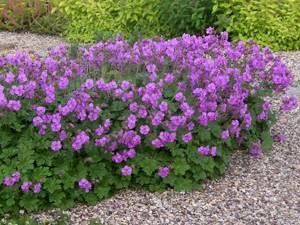
Lilac flowering bushes
How to grow Geranium in the garden
Because many varieties come from several different species, Geraniums vary in their care needs, depending on the species and variety you plant. This plant tolerates the conditions of our climate well. Let us describe the general criteria for trouble-free flower care.
Landing of the Crane
Select a planting site that receives full sun to partial shade. Plant your flower where it will have enough space to grow. Depending on the variety, your plant will grow up to 15 – 60 cm in height with a similar width.
Amend the soil with organic material, such as compost, before planting. This helps retain moisture in the soil and also nourishes your plant. Add perlite to your soil if you want to improve drainage.
Add a slow-release fertilizer to the planting area and water the soil well. Follow label directions for new plantings. Plant the Crane Tree so that the beginning of the crown is flush with the soil. Planting deeper can quickly cause crown rot.
What kind of lighting does a flower need?
For best flowering and Geranium plants, place them in a sunny or partial shade location. If the flower is grown in hot and bright sun, provide it with regular watering. Some varieties of Geranium will tolerate full shade, but they will not bloom as profusely as those that receive a lot of sun.
What soil is suitable for the plant?
Geranium is not picky about soil pH, but neutral or slightly acidic soil is the best choice. Most species of Geranium prefer medium-moisture, well-drained soil, although some species require relatively dry soil.
Watering
Geranium is an unpretentious plant, so it needs to be watered only when the soil is dry. If the flowers are in full sun, water them more often. Geraniums can be susceptible to fungal diseases if watered from above.
Temperature and humidity
Crane grass grows best at daytime temperatures from 18 to 24 °C and night temperatures from 10 to 15 degrees. The plant tolerates a wide range of humidity.
Fertilizers
If the soil is fertile enough, “Stork’s Beak” does well without fertilizing. Feed it once a year with compost. Poor soils may require spring feeding with fertilizers.
Trimming
Young pelargonium plants can be pinched back in spring or early summer to encourage branching and thus produce more flowers.
Wintering of the Crane
If you live in a region with cold winters, you should dig the flowers in the fall, before the temperature drops below 5°C.
First, prune by removing any dead, dying, damaged or diseased growth. Cut them about halfway. Then place them in pots large enough to accommodate their root ball and add a little compost on top. Then place them in a cool, well-lit area.
Types and varieties of perennial garden geraniums
These types of garden geraniums are considered the most popular among gardeners.
Balkan
Perennial garden violet in open ground
It has a powerful and long rhizome. Growing up, perennial rhizomatous geranium can form real thickets.
The flowers of this species are reddish or purple in color. The size of the flowers is not very large - when open, their diameter is no more than 3 centimeters. The height of the bush does not exceed 30 centimeters. The flowering period begins in early June and lasts for one month.
The most popular varieties of Balkan geranium are: tree-like Insversen, Spessagt and Variegata.
For information: flower lovers say that red pelargonium Czakor looks no less attractive.
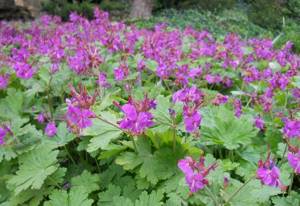
Balkan variety
Blood Red
Flowers of this species are simple and double, in appearance they are very similar to garden roses. Red-brown geranium can bloom profusely and grow without replanting for more than 10-12 years. When growing, the plant is very demanding and needs to follow all the rules of care.
It is preferable to plant geranium sanguineum in partial shade, but it will also grow well in sunny areas, only then you will have to water it more often. The soil for planting this variety should be slightly alkaline or neutral.

Blood Red
Bolotnaya
It has medium-sized purple flowers, branched and erect stems, growing up to 70 centimeters in height.
The bush is quite dense and not very large. Begins to bloom in June.

Marsh blooms with lilac flowers
Georgian
This type of bush geranium is characterized by low maintenance, resistance to temperature changes and drought.
The flowers of this species are purple in color and during flowering they completely cover the entire bush.
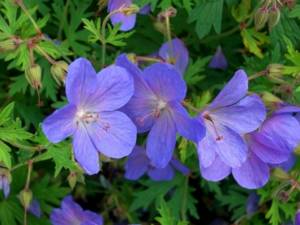
Georgian blooms with lilac flowers
short
This variety of geranium is especially popular among landscape designers. This plant is good because it is small - the bush grows up to 15 centimeters in height.
The flowers of this geranium are lilac-pink in color, small - no more than 3 centimeters in diameter. The leaf blades of the flower are gray-green. Flowering continues from early July to late August.

Undersized blooms in the garden
creeping
Ground cover geranium has thin roots and graceful dissected leaves with small petioles.
The flowers are pale pink in color and have an amazing aroma. The flowers are no more than 3 centimeters in size. The flowering period begins in early June and continues until the end of September.
This creeping geranium looks very beautiful. After the first frost, the leaves acquire a pink-red hue and soon dry out and fall off.
Among all the varieties of creeping geranium, the most popular is the Patracia garden geranium, the flowers of which are usually pale pink in color; it looks very beautiful in flower beds and alpine hills, as well as the Blue Blood variety - a blue geranium with a purple tint.
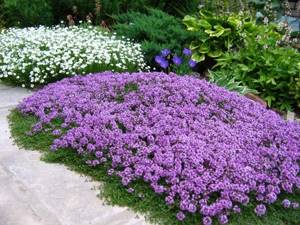
Creeping carpet
Main types
Various types of geraniums can grow in open ground. They differ in the size and color of the buds, and care requirements. It is important to know how to choose the right type of plant for a particular area. The most popular types of plants are:
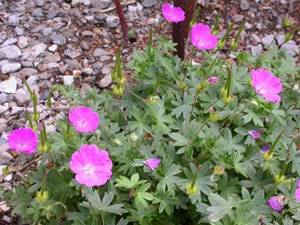
Garden geranium blood-red variety "Max Fry"
| View | Short description |
| Large-flowered or Himalayan. | The height of the bush can reach 30-50 cm. The leaves reach 10 cm, the buds are large - 5 cm, and have reddish or purple veins. It is not easy to care for the varieties of this species. |
| Bolotnaya | Grows up to 70 cm in height. The flowers are purple and medium in size. The plant blooms in summer |
| Lugovaya | Reaches a height of 1.2 meters. The bush is dense, the buds are purple. Flowering occurs in mid-summer |
| Gorgeous | The bush grows up to half a meter in height. The buds can be brick-colored or purple. The most striking representative of the species is the variety Mrs. Kendall Clark |
| Balkan | A distinctive feature is the long rhizome. The flowers are purple or red. The bush grows up to 30 cm in height. The most famous varieties of the species are Czakor and Insversen |
| Georgian | An excellent option for those who do not have a lot of time to care for the plant. There are many flowers on the bush, their color is purple. The lifespan of geranium without transplantation is up to 12 years |
| Blood red | The buds of this species resemble roses. The perennial can live up to 15 years. In order for geranium to bloom well, it should be planted in partial shade, on neutral soil. |
Interesting read: Balkan geranium
Geranium in landscape design
When mixed planting in flower beds and alpine hills, the flower goes well with other flowering and evergreen plants. Creates a background and gives support to other flowers prone to lodging. Perennial geranium is considered a universal plant for the garden; it is loved by gardeners and landscape designers.
Perennial jasmine - planting and care in open ground
To create a beautiful border around a flower bed or garden path, use magnificent geranium. To create attractive variegated spots on the garden lawn, it is better to use small-flowered garden geranium; it will look like a ballerina. On the outskirts of shrubby plantings, blood-red geranium will look beautiful. This look will look natural in an orchard.
Perennial geranium is an irreplaceable plant in the garden; its numerous species make it possible to choose the ideal plant for each individual occasion.
The plant goes well with various perennials and other “residents” of the garden; it is a perfect neighbor:
- asters,
- primrose,
- roses,
- hosta and others.
Additional Information! Thanks to the variety of shades of geranium, as well as its height, which varies from 10 to 125 cm, outdoor geranium goes well with various plants and can be used to create a wide variety of compositions.
Transplantation after purchase into open ground
After purchasing a perennial garden geranium, it must be properly planted in its permanent place of growth - in open ground. To do this, you need to choose the right place and prepare the ground.
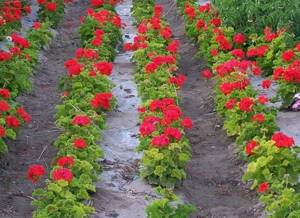
Planted in a flowerbed
Site selection and land preparation
Garden geranium grows well in well-lit places, but will also feel great in places shaded by other shrubs.
Outdoor garden geranium does not have any special requirements for the composition of the soil - the main thing is that it is well-drained and breathable.
The planting area must be dug up several days before planting. Rotted peat, compost and a little sand must be added to the soil.
Landing
The process of planting geraniums step by step:
- The hole for planting must be dug 15-20 centimeters deeper than the length of the roots of the seedling.
- Place a layer of expanded clay, crushed stone or small stones at the bottom of the planting hole.
- Place a layer of nutrient mixture in the form of a slide on the drainage layer.
- Place the plant vertically, spreading the roots well over the entire surface of the ground.
- Sprinkle with garden soil and lightly compact the soil around the stem.
- Water the bush well and mulch the ground around it.
- When planting young shoots, you should maintain a distance between bushes of at least 40 centimeters for tall varieties and at least 25 cm for short ones.
Important! After planting, young seedlings must be shaded for several days from active exposure to sunlight and watered well.
Geranium propagation
Garden geranium propagates very easily by growing seedlings from seeds.
Growing from seeds
Planting seeds and growing seedlings step by step:
- Collect fresh geranium seeds or buy ready-made ones at a flower shop.
- Sow in a seedling pot filled with nutritious soil consisting of peat and sand.
- Water the plantings and cover with cling film.
- Ensure the air temperature is at least +25 degrees and timely watering.
- When the shoots appear, the temperature must be lowered to +20-22 degrees.
- When two or three true leaves appear, the plants must be transplanted into separate pots.
- Planting outside can be done only when the flower gets stronger and grows to 10-15 cm in height.
Care
Despite its low maintenance requirements, the flower blooms more magnificently and profusely if it is given due attention.
- Watering mode
Water the perennial regularly as the top layer of soil dries. Young plants especially need frequent watering.
During dry periods, watering should be frequent (2-3 times a week). If the plant grows in bright sun and the leaves droop during the period of its activity, after abundant watering they will quickly restore their shape.
- Top dressing
There will be an undoubted benefit if you apply mineral fertilizers during the active growing season. For good growth of the bush and bright green foliage, spring feeding with liquid mullein or diluted humus.
Note! For abundant and long flowering, the perennial must be fertilized twice a month.
- Caring for perennials during flowering
When the plant blooms, timely removal of faded buds is carried out - this will allow new ones to bloom. Periodically it is necessary to loosen the soil and remove weeds.
Once a month, it is important to carry out preventive treatment with fungicides - this will help protect the plant from possible diseases. Once every two weeks it is necessary to change the layer of mulch around the bushes.
- Features of care during the rest period
During the dormant period, preventive pruning of bushes is carried out - yellow, dry leaves, dead side shoots and broken stems are cut off. This will improve the health of the bush and promote more active growth.
Note! In late autumn, complete pruning of bushes is carried out.
Types of garden Geranium
Among the frequently occurring species, it is worth highlighting several
Dark brown or red-brown Geranium (Geranium phaeum)
Perennial variety with a well-developed, creeping root system. Its stem reaches 60 centimeters, the buds are bright red.
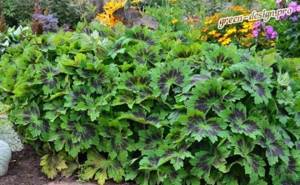
Red-brown geranium
The flowering period is from early June to late July. The flower got its name due to the fact that by autumn the ground part of the bush acquires a reddish-brown hue.
Meadow geranium (Geranium pratense)
Another perennial, with a thin rhizome. The erect growing ascending stem reaches 20-60 cm.

Photo of meadow Geranium
During the flowering period (June-August), delicate blue-violet flowers decorated with dark veins are formed in the axils of the leaves on thin peduncles.
White-flowered geranium (Geranium albiflorum)
A perennial flower reaching a height of 60 cm. The leaves are pentagon-shaped, up to 7 centimeters wide, the stem is slightly pubescent.

Photo of white-flowered geranium
On one peduncle there are two flowers of white, lilac, light lilac shades.
Preparing for winter
Most types of garden geranium have good frost resistance and therefore can winter quietly without additional shelter for the ground part of the plant. However, some maintenance measures will still need to be carried out.
In the fall, when the bush withers and dries, remove all above-ground stems and leaves. To protect the roots from possible freezing, thick-layer mulching is carried out using organic components - garden compost, sawdust, tree bark, pine needles, and dry mullein.
By planting perennial geranium in the garden, you can get a rather unpretentious and beautiful flower, which is beautiful not only on its own, but also in combination with other garden plants. With its help you can decorate any flower bed, front garden, garden or summer cottage.
